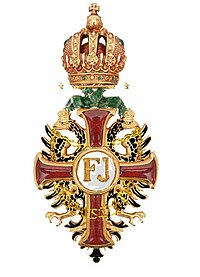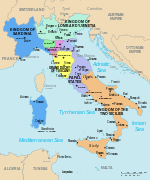Order of Franz Joseph
| Imperial Order of Franz Joseph | |
|---|---|
 Badge of the Order | |
| Awarded by | |
| Type | Order of merit (1849–1918) Dynastic order (1918—) |
| Established | 2 December 1849 |
| Royal house | House of Habsburg |
| Motto | VIRIBUS UNITIS ("With United Forces") |
| Awarded for | Civil and Military Merit |
| Status | Dormant Order since 1918 |
| Sovereign | Crown Prince Karl of Austria |
| Grades | Knight Grand Cordon with Collar Knight/Dame Grand Cordon Knight/Dame Grand Officer Knight/Dame Commander Knight/Dame Officer Knight/Dame |
| Statistics | |
| First induction | 1849 |
| Last induction | 1918 |
| Precedence | |
| Next (higher) | Order of the Iron Crown Order of Elizabeth |
| Next (lower) | Order of Saint George Order of Elizabeth and Theresa |
Ribbon of the Order | |
The Imperial Austrian Order of Franz Joseph (German: Kaiserlich-Österreichischer Franz-Joseph-Orden) was founded by Emperor Franz Joseph I of Austria on 2 December 1849, on the first anniversary of his accession to the imperial throne.
Classes[]
The order was originally awarded in three classes: Grand Cross, Commander's Cross, and Knight's Cross. In 1869, the class of Commander with Star was added, which ranked immediately below the Grand Cross. The Officer's Cross, which ranked between Commander and Knight, was introduced on 1 February 1901.
The order ceased to exist as a governmental award with the dissolution of the Austro-Hungarian Empire in 1918. It was not re-established with the foundation of the Republic of Austria. However, it remains active as a dynastic order of the House of Habsburg.
Description[]
Knights wore the decoration suspended from a triangular ribbon on the left breast. Officers wore it on the left breast without a ribbon. Commanders wore the decoration at the neck, as did Commander with Star, who also wore a breast star. The Grand Cross was worn suspended from the shoulder and also came with a breast star. The ribbon of all classes of the order was plain red.
In common with the other Austro-Hungarian awards of the period, the Franz Joseph Order was further distinguished with the addition of the War decoration and Swords which could be awarded for military merit. However, if soldiers were honoured, it was usually for distinguished service as opposed to gallantry in the face of the enemy.
Notable recipients[]


- Živojin Mišić
- Émile Baudot[1]
- Benjamin Thomas Brandreth-Gibbs
- Anton Bruckner[2]
- Paškal Buconjić
- Georg Decker, portrait artist[3]
- Abraham Salomon Camondo
- Nezir Škaljić
- Baron Adrien Goffinet
- Prince Julius
- Hans Gude[4]
- Carl von In der Maur
- Ndre Mjeda
- Gjergj Fishta
- Sultan Hussein Kamel of Egypt & Sudan
- Auguste, Baron Lambermont
- Jan Matejko
- Johann Münzberg
- Philipp Sarlay
- Napoleon Touzet[5]
- Anton Dreher[6]
- Anton Dreher Jr.[7]
See also[]
- Nobility
- Order of chivalry
- Order of Leopold
- Order of St. George (Habsburg-Lorraine)
- Order of the Iron Crown
- Orders, decorations, and medals of Austria-Hungary
References[]
- ^ p. 33, Butrica (1991) Andrew J. Boca Raton, Florida "Baudot, Jean Maurice Emile" Froehlich, Kent (editors) Fritz E., Allen The Froehlich/Kent Encyclopedia of Telecommunications Vol. 2 CRC Press
- ^ Watson, Derek Bruckner. New York: Schuster & Macmillan (1997): 39
- ^ Morgen-Post Wien, 27 November 1872 (p. 579)
- ^ Waters, Clara Erskine Clement; Hutton, Lawrence (1879), "Hans Frederic Gude", Artists of the nineteenth century and their works: A handbook containing two thousand and fifty biographical sketches, 1, Bostom: Houghton, Osgood and company, p. 317, retrieved 12 July 2017
- ^ Österreichische Zeitschrift für praktische Heilkunde (in German). Veit. 1839.
- ^ Eduard Hensel (1864). Anton Dreher, biographische Skizze (in German). p. 27.
- ^ Geschichte der österreichischen Land- und Forstwirtschaft und ihrer Industrien 1848–1898 (in German). 1899. p. 538.
External links[]
![]() Media related to Imperial Order of Franz Joseph at Wikimedia Commons
Media related to Imperial Order of Franz Joseph at Wikimedia Commons
- Orders of chivalry of Austria
- Orders, decorations, and medals of Austria-Hungary
- 1849 establishments in the Austrian Empire
- Orders, decorations, and medals of the Austrian Empire
- Awards established in 1849

